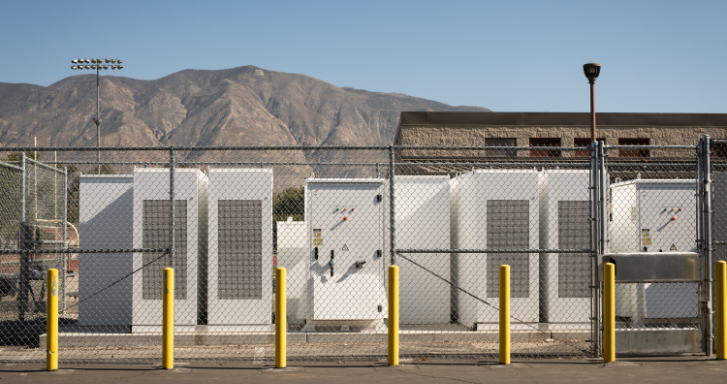
Understand Your Microgrid Options
Are you interested in deploying a microgrid in SCE territory? Find out what types of interconnections SCE supports and what’s required to properly install and establish your microgrid.
Interconnection Options for SCE Territories
Based on the current California Public Utilities Commission (CPUC) approved rules and regulations, customers and third parties can develop Behind-The-Meter (BTM) microgrids. The way your microgrid interconnects to the SCE electric grid will depend on your preferred method of operation and your project’s complexity, type of generation, and applicable tariffs.
Rule 21 Applications
Non-Export
This microgrid normally operates in parallel with the SCE grid and does not continuously export power back to the grid.
Isolated Operations
Composed of backup generation, this system operates on “isolated operation mode” and is not connected to the SCE grid. This system always requires an open transition to and from the grid and may include energy storage.
Momentary Parallel Operations
This system is composed of backup generation and may include energy storage, but the backup generation is not normally operational. When its backup generation function or energy storage is activated, it may connect in parallel with the grid for less than one second. After connecting, it then separates to provide backup service only to the facility.
NEM Interconnection with Eligible Paired Storage
Based on an NEM (Net Energy Metering) tariff that allows paired storage, this system normally operates in parallel with the SCE grid and provides energy to either power the microgrid or export energy to the grid in accordance to NEM tariff rules.
Application Process

Submit your application package and fee (if applicable). We’ll assign an engineer to your project to review the technical information.

After your application has been approved, you will need to demonstrate that your generator or energy storage complies with Rule 21 requirements where applicable.

After all inspections have been completed, you will receive a notification authorizing the operation of your generation system.
Application Requirements
This application is suited for configurations where generation is utilized onsite. This microgrid normally operates in parallel with the SCE grid and provides energy to host customer needs. As its name suggests, this microgrid does not continuously export power back to the grid. You can enhance this system with additional controls, allowing you to separate from the grid when it is unavailable (e.g., power outages) or other times you want to disconnect.
FIGURE 1: Behind-The-Meter (BTM) Microgrid Application
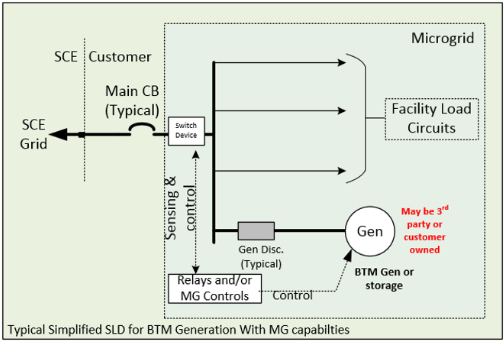
Rules:
- Must submit a Rule 21 Interconnection Application with relevant information (technical and non-technical) to SCE
- Customer (or third party and customer if generation is owned by a third party) must enter into a Rule 21 Interconnection Agreement with SCE
- Must receive a Permission to Operate (PTO) from SCE
Operating Rules:
Normal Operating Rules:
- Operates in parallel with the grid as non-export or inadvertent export in accordance with Interconnection Agreement
Microgrid Operation:
- In microgrid operation, the generation facility and customer load must separate from the SCE grid by opening a device designed for that purpose such as a breaker or other disconnecting device
- The relay and/or control systems must prevent the closing of the microgrid to the SCE grid while the SCE grid is not energized to prevent unintentional islanding
Return to Normal Operation:
- When SCE grid returns to normal, the relay and control systems must reconnect the microgrid back to the SCE grid in a manner that does not cause issue to the SCE grid by: (1) utilizing proper synchronization controls, or (2) following proper sequence of operations, such as by disconnecting the generation prior to closing the microgrid to the SCE grid (experience a temporary outage)
- Must allow the SCE grid to return to steady state normal conditions for a minimum of 5 minutes prior to closing to the SCE grid
- All relays settings, inverter settings (such as anti-islanding detection), and required limitations of operation must be in place and operational per the Interconnection Agreement requirement prior to reconnecting the microgrid to the SCE grid.
Rule 21 Interconnection Rates and Rules:
- Rule 21 non-exporting or inadvertent export provision applies
- Customer to submit Non-Export Interconnection Request to SCE. Visit www.sce.com/gridinterconnection for more information.
- SCE must issue a Permission to Operate (PTO) and execute an Interconnection Agreement prior to operation.
Cost Responsibility in Various Microgrid Ownership/Operational Models:
- Customer responsible for testing, operating and maintaining all equipment necessary to maintain a safe operation of the Generating Facility under normal operation or under a Microgrid operations
- Rule 21 Interconnection Agreements and tariffs apply
Application Checklist
- Submit an Interconnection Application with the following requirements
a. Technical information related to the generator and transformation
b. Single and Three Line Diagram
c. Plot plans identifying location of relevant electrical devices
d. Relaying Elementary and/or Control Diagrams
e. Relay settings and certified test reports
f. Inverter-based generation and storage must have UL certification and be listed in the CEC inverter listing.
g. Application fee - Executed Interconnection Agreement
- Certificate of Insurance as required per the Executed Interconnection Agreement
- As-Built Single Line Diagram
- Received Permission To Operate (PTO) from SCE
- Authority Having Jurisdiction Sign Off
This application is suited for configurations where microgrid capabilities are applied while disconnected from SCE’s grid. This interconnection falls under the Isolated Operations Generator option of the Rule 21 tariff. Composed of backup generation, this system would normally operate on “isolated operation mode” and not connected to the SCE grid, including when there is a power outage or other instances disconnecting from the grid is desired. This method of operation always requires an open transition back to and from the grid. While all technologies or combination of technologies are qualified for this option, the system must have adequate equipment and/or controls to separate customer needs from the grid and then re-energize customer needs via backup generator system. A typical simplified diagram of this microgrid is depicted in Figure 2.
FIGURE 2: Behind-The-Meter (BTM) Microgrid Application with backup generation
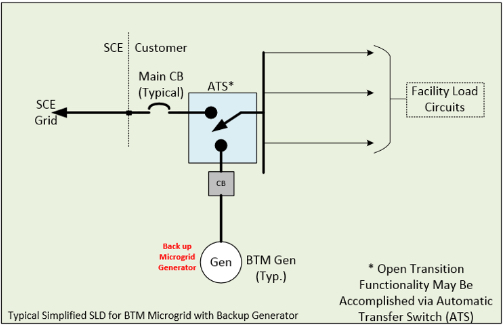
Legal Requirements:
- Must submit a Rule 21 Interconnection Application Indicating Isolated Operation
- Acknowledgement from SCE on adequacy of transfer is scheme is required
Operating Rules:
Normal Operating Rules:
- Operates isolated from the grid. BTM Microgrid never parallels with the grid even on a momentary basis
Microgrid Operation:
- In microgrid operation, the generation facility and customer load must separate (disconnected) from the SCE grid by a breaker or other type of disconnection device (typically via an ATS)
- The control systems and/or equipment shall never allow parallel operation with the SCE grid even on a momentary basis
- Transition to BTM microgrid operation shall always be via open transition where the SCE grid system is first disconnected (whether the grid is energized or not) and the subsequent the microgrid generation engaged to serve customer needs.
Return to Normal Operation:
- When SCE grid returns to normal, customer needs must be transferred to the SCE grid via an open transition requiring the generator to be disengaged and disconnected prior to connecting the microgrid back the SCE grid. SCE prefers that a single pole ATS be used for this function but other control options may provide the same function.
Rule 21 Interconnection Rates and Rules:
- Rule 21/NEM application operating under the Isolated Operation Option
- Customer to submit Rule 21 interconnection request to SCE. Visit www.sce.com/gridinterconnection for more information.
- Acknowledgement from SCE on adequacy of transfer is scheme is required
Cost Responsibility in Various Microgrid Ownership/Operational Models:
Customer liable for testing, operating and maintaining all equipment necessary to maintain a safe operation of the Generating Facility under normal operation or under a Microgrid operations
Application Checklist:
- Submit an Interconnection Application with the following requirements:
a. Technical information related to the generator and transformation
b. Open transition control and/or device (such ATS information)
c. Single Line Diagram
d. Sequence of operations - Received Permission To Operate (PTO) from SCE
This application is suited for configuration in which generation is utilized onsite and disconnected from SCE’s grid. Momentary Parallel Operations option within Rule 21 allows for generation to connect in parallel with the grid for less than one second. After connecting, the microgrid would separate from the grid to provide backup service to accommodate customer needs.
All technologies or combination of technologies are qualified for this option, but this system must have adequate equipment and/or controls to separate the microgrid from SCE’s grid when the grid is unavailable (e.g., a power outage) or when disconnection is desired. This method of operation can use a momentary closed transition back to and from the grid. A typical simplified diagram is depicted on Figure 4.
FIGURE 4: Behind-The-Meter (BTM) Microgrid Application with Momentary Parallel Backup Generation
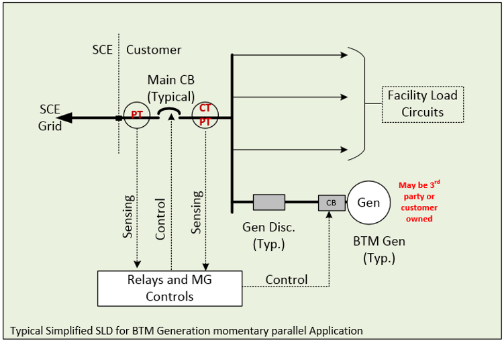
Legal Requirements:
- Must submit a Rule 21 Interconnection Application Indicating Momentary Operation
- SCE provide approval of requested operating mode
Operating Rules:
Normal Operating Rules:
- Operates isolated from the grid. BTM Microgrid parallels with the grid on a momentary basis to transfer between microgrid operation and normal grid connected operation.
Microgrid Operation:
- Separate (disconnect) the BTM microgrid (customer needs and generation) from the SCE grid by opening a device designed for that purpose such a breaker or a disconnect device (typically via an ATS)
- The control systems and/or equipment may parallel momentarily with the SCE grid
- Transition to BTM microgrid operation shall can be momentary closed transition where the SCE grid system and the microgrid generation are in parallel for less than one (1) second
Return to Normal Operation:
- When SCE grid returns to normal, customer needs can be transferred to the SCE grid via a momentary closed transition.
Rule 21 Interconnection Rates and Rules:
- Rule 21 application operating under the Momentary Operation Option
- Customer to submit Rule 21 interconnection request to SCE. Visit www.sce.com/gridinterconnection for more information.
- Acknowledgement from SCE on adequacy of transfer is scheme is required
Cost Responsibility in Various Microgrid Ownership/Operational Models:
Customer liable for testing, operating and maintaining all equipment necessary to maintain a safe operation of the Generating Facility under normal operation or under a Microgrid operations
Application Checklist:
- Submit an Interconnection Application with the following requirements:
a. Technical information related to the generator and transformation
b. Single Line Diagram
c. Sequence of operations - SCE provide approval of requested operating mode As-built Single Line Diagram
- Received Permission To Operate (PTO) from SCE
This application is suited for configurations where qualified renewable generation is utilized. The installation of this microgrid is based on an NEM tariff that allows paired storage. This system normally operates in parallel with the SCE grid, providing energy to host customer needs or exporting energy to the grid following NEM tariff provisions. You can enhance this system with additional controls that can separate your system from the grid when the grid is unavailable or other times when isolation is desired. Your desired method of operations, such as open or close transition, the ability to withstand short-term power outages, and desired level of microgrid support (full facility or partial) will drive the complexity of the control, relays and electrical design. A typical simplified diagram is depicted in Figure 3.
FIGURE 3: Behind-The-Meter (BTM) NEM with Storage Microgrid Application
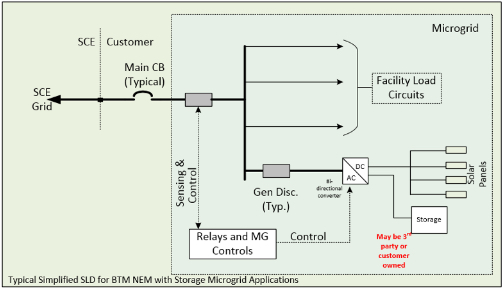
Legal Requirements:
- Must submit an NEM Interconnection Application
- Must have an NEM Executed Interconnection Agreement
- Must receive a Permission to Operate (PTO) from SCE
- NEM renewable source must limit size to serve host customer electrical needs in accordance to the NEM rate
Operating Rules:
Normal Operating Rules:
- Operates in parallel with the grid in compliance with NEM Interconnection Agreement
Microgrid Operation:
- In microgrid operations, the NEM generation facility and customer load must separate (disconnected) from the SCE grid by opening a breaker or other type of disconnection device
- The relay and/or control systems must prevent the closing of the Microgrid to the SCE grid while the SCE grid is not energized to prevent unintentional islanding
Return to Normal Operation:
- When SCE grid returns to normal, the relay and control systems must reconnect the Microgrid back to the SCE grid in a manner that does not cause issue to the SCE grid by (1) utilizing proper synchronization controls, or (2) by following proper sequence of operations, such as by disconnecting the generation prior to closing the Microgrid to the SCE grid (experience a temporary outage)
- All relays settings, inverter settings (such as anti-islanding detection), and required limitations of operation must be in place and operational per the Interconnection Agreement requirement prior to reconnecting the Microgrid to the SCE grid.
NEM Interconnection Rates and Rules:
- NEM application operating under NEM requirements
- Customer to submit NEM interconnection request to SCE.
- SCE must issue Permission to Operate (PTO) and execute an NEM Interconnection Agreement prior to operation
Cost Responsibility in Various Microgrid Ownership/Operational Models:
- Customer responsible for testing, operating and maintaining all equipment necessary to maintain a safe operation of the Generating Facility under normal operation or under Microgrid operations
- NEM Interconnection Agreements and rates apply
Application Checklist:
- Submit an Interconnection Application with the following requirements:
a. Technical information related to the generator and transformation
b. Single and Three Line Diagram
c. Plot plans identifying location of relevant electrical devices
d. Inverter-based generation and storage must have UL certification and be listed in the CEC inverter listing.
e. Relaying Elementary and/or Control Diagrams
f. Relay settings and certified test reports
g. Application fee
h. Site control documentation required for NEM-ST generators > 1 MW. - Executed Interconnection Agreement
- Certificate of Insurance pursuant to the Interconnection Agreement (applicable to all NEM generation >1MW, NEM-Fuel Cell Generation)
- As-Built Single Line Drawing
- Received Permission To Operate (PTO) from SCE
- Authority Having Jurisdiction Sign Off
Why do we need Interconnection Agreements?
Here are a few of the reasons why Interconnection Agreements are critical to the continued safe and reliable operation of the electric grid.
- Safety: Uncontrolled energy can be harmful to both people and equipment. California Title 8 (Safety Code) requires you to coordinate with SCE to help keep everyone safe.
- Non-Discrimination: Access to the grid is available to all parties and customers, from small independent facilities to large commercial operations.
- Stability and Reliability: Generators can impact grid operations and system planning. A streamlined process and agreements help ensure everyone is aligned.
- Cost Responsibility: Depending on the interconnection process and rules applicable to your specific project, costs for network upgrades may be shared with other projects, and/or may be refundable. You will be responsible for any distribution upgrade and interconnection facilities costs that are unique to your specific project.
- Compliance: You must follow applicable rules and regulations from the CPUC and SCE. These will vary depending on which interconnection option you choose.
Contact Us
Email: microgrids@sce.com
Phone: (626) 302-3688
Mailing Address:
Grid Interconnection & Contract Development
Southern California Edison
2244 Walnut Grove Ave
Rosemead, CA 91770
Want to get announcements about interconnection events?
Email: interconnections@sce.com
To address disputes regarding rule 21 missed timelines, contact:
SCE’s Appointed Ombudsman: Rod Vickers, Project Manager
Email: Rule21.Ombudsman@sce.com
Phone: (714) 895-0211
Additional Resources
These pages can help you get more information about specific microgrid requirements.
Frequently Asked Questions
A microgrid has the ability to disconnect from the grid and continue to serve customers within the microgrid boundary in the event of an outage. In order to provide this service, dedicated equipment is required in addition to any generation or storage sized to provide power to the connected customer needs.
A microgrid can be custom designed to meet customer needs. The length of time that microgrid can provide power depends on the type of technology resources being used, such as storage and solar and the demand from the customer. In general, a microgrid for a residential home with 13.5kWh amount of capacity can provide service for 12-15 hours.
If you want to generate your own power, the Self Generation Incentive Program (SGIP) could be a good option for your home or business. For more information, visit the Self-Generation Incentive page.
Are you interested in solar or other clean energy? Our Net Energy Metering page has more information for you.
If you want to generate and export to SCE’s grid, there are options available. Visit Grid Interconnections for more information.

Join Us in Creating a Clean Energy Future
Microgrids often tap into renewable energy resources, which helps us get closer to our goal of a carbon-free future for California.
